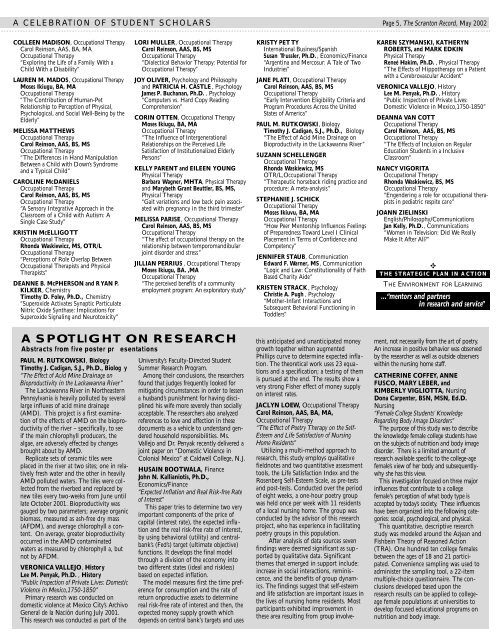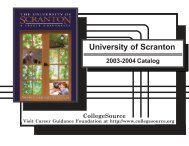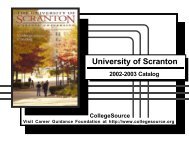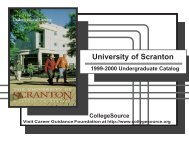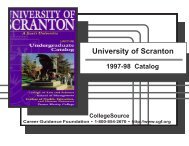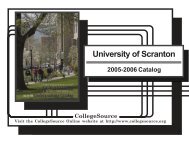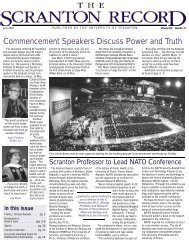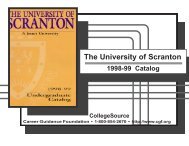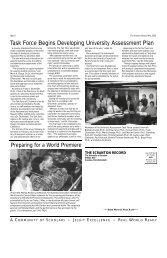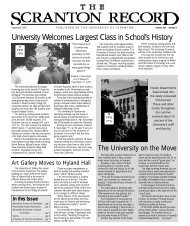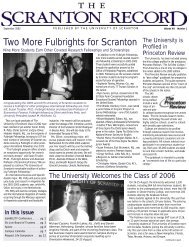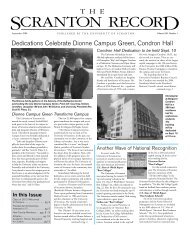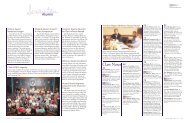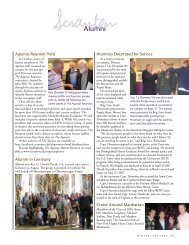Commencement Speakers Announced - The University of Scranton
Commencement Speakers Announced - The University of Scranton
Commencement Speakers Announced - The University of Scranton
You also want an ePaper? Increase the reach of your titles
YUMPU automatically turns print PDFs into web optimized ePapers that Google loves.
A C E LE B R AT I O N O F ST U D E NT S C H O L A R S Page 5, <strong>The</strong> <strong>Scranton</strong> Record, May 2002<br />
COLLEEN MADISON, Occupational T h e r a p y<br />
Carol Reinson, AAS, BA, MA<br />
Occupational <strong>The</strong>rapy<br />
“Exploring the Life <strong>of</strong> a Family With a<br />
Child With a Disability”<br />
LAUREN M. MADOS, Occupational T h e r a p y<br />
Moses Ikiugu, BA, MA<br />
Occupational <strong>The</strong>rapy<br />
“<strong>The</strong> Contribution <strong>of</strong> Human-Pet<br />
Relationship to Perception <strong>of</strong> Physical,<br />
Psychological, and Social Well-Being by the<br />
Elderly”<br />
MELISSA MATTHEWS<br />
Occupational <strong>The</strong>rapy<br />
Carol Reinson, AAS, BS, MS<br />
Occupational <strong>The</strong>rapy<br />
“<strong>The</strong> Differences in Hand Manipulation<br />
Between a Child with Down’s Syndrome<br />
and a Typical Child”<br />
CAROLINE McDANIELS<br />
Occupational <strong>The</strong>rapy<br />
Carol Reinson, AAS, BS, MS<br />
Occupational <strong>The</strong>rapy<br />
“A Sensory Integrative Approach in the<br />
Classroom <strong>of</strong> a Child with Autism: A<br />
Single Case Study”<br />
KRISTIN McELLIGOTT<br />
Occupational <strong>The</strong>rapy<br />
Rhonda Waskiewicz, MS, OTR/L<br />
Occupational <strong>The</strong>rapy<br />
“Perceptions <strong>of</strong> Role Overlap Between<br />
Occupational <strong>The</strong>rapists and Physical<br />
<strong>The</strong>rapists”<br />
DEANNE B. McPHERSON and R YAN P.<br />
KILKER, Chemistry<br />
Timothy D. Foley, Ph.D., Chemistry<br />
“Superoxide Activates Synaptic Particulate<br />
Nitric Oxide Synthase: Implications for<br />
Superoxide Signaling and Neurotoxicity”<br />
LORI MULLER, Occupational <strong>The</strong>rapy<br />
Carol Reinson, AAS, BS, MS<br />
Occupational <strong>The</strong>rapy<br />
“Dialectical Behavior <strong>The</strong>rapy: Potential for<br />
Occupational <strong>The</strong>rapy”<br />
JOY OLIVER, Psychology and Philosophy<br />
and PATRICIA H. CASTLE , Psychology<br />
James P. Buchanan, Ph.D. , Psychology<br />
“Computers vs. Hard Copy Reading<br />
Comprehension”<br />
CORIN OTTEN, Occupational <strong>The</strong>rapy<br />
Moses Ikiugu, BA, MA<br />
Occupational <strong>The</strong>rapy<br />
“<strong>The</strong> Influence <strong>of</strong> Intergenerational<br />
Relationships on the Perceived Life<br />
Satisfaction <strong>of</strong> Institutionalized Elderly<br />
Persons”<br />
KELLY PARENT and EILEEN YOUNG<br />
Physical <strong>The</strong>rapy<br />
Barbara Wagner, MHTA, Physical <strong>The</strong>rapy<br />
and Marybeth Grant Beuttler, BS, MS,<br />
Physical <strong>The</strong>rapy<br />
“Gait variations and low back pain associated<br />
with pregnancy in the third trimester”<br />
MELISSA PARISE, Occupational <strong>The</strong>rapy<br />
Carol Reinson, AAS, BS, MS<br />
Occupational <strong>The</strong>rapy<br />
“<strong>The</strong> affect <strong>of</strong> occupational therapy on the<br />
relationship between temporomandibular<br />
joint disorder and stress”<br />
JILLIAN PERRIUS , Occupational <strong>The</strong>rapy<br />
Moses Ikiugu, BA. ,MA<br />
Occupational <strong>The</strong>rapy<br />
“<strong>The</strong> perc e i ved benefits <strong>of</strong> a community<br />
e m p l oyment program: An exploratory study”<br />
A SPOT LI GHT ON RESE A R C H<br />
Abstracts from five poster pr e s e n ta t i o n s<br />
PAUL M. RUTKOWSKI, Biology<br />
Timothy J. Cadigan, S.J., Ph.D., Biolog y<br />
“<strong>The</strong> Effect <strong>of</strong> Acid Mine Drainage on<br />
Bioproductivity in the Lackawanna River”<br />
<strong>The</strong> Lackawanna River in Northeastern<br />
Pennsylvania is heavily polluted by several<br />
large influxes <strong>of</strong> acid mine drainage<br />
(AMD). This project is a first examination<br />
<strong>of</strong> the effects <strong>of</strong> AMD on the bioproductivity<br />
<strong>of</strong> the river – specifically, to see<br />
if the main chlorophyll producers, the<br />
algae, are adversely effected by changes<br />
brought about by AMD.<br />
Replicate sets <strong>of</strong> ceramic tiles were<br />
placed in the river at two sites; one in relatively<br />
fresh water and the other in heavily<br />
AMD polluted waters. <strong>The</strong> tiles were collected<br />
from the riverbed and replaced by<br />
new tiles every two-weeks from June until<br />
late October 2001. Bioproductivity was<br />
gauged by two parameters; average organic<br />
biomass, measured as ash-free dry mass<br />
(AFDM), and average chlorophyll a content.<br />
On average, greater bioproductivity<br />
occurred in the AMD contaminated<br />
waters as measured by chlorophyll a, but<br />
not by AFDM.<br />
VERONICA VALLEJO, History<br />
Lee M. Penyak, Ph.D. , History<br />
“Public Inspection <strong>of</strong> Private Lives: Domestic<br />
Violence in Mexico,1750-1850”<br />
Pr i m a ry re s e a rch was conducted on<br />
domestic violence at Mexico City’s Arc h i vo<br />
General de la Nación during July 2001.<br />
This re s e a rch was conducted as part <strong>of</strong> the<br />
Un i ve r s i t y’s Fa c u l t y - Di rected St u d e n t<br />
Summer Re s e a rch Program.<br />
Among their conclusions, the re s e a rc h e r s<br />
found that judges frequently looked for<br />
mitigating circumstances in order to lessen<br />
a husband’s punishment for having disciplined<br />
his wife more seve rely than socially<br />
acceptable. <strong>The</strong> re s e a rchers also analyze d<br />
re f e rences to love and affection in these<br />
documents as a vehicle to understand gend<br />
e red household responsibilities. Ms.<br />
Vallejo and Dr. Penyak recently delive red a<br />
joint paper on “Domestic Violence in<br />
Colonial Me x i c o” at Caldwell College, N.J.<br />
HUSAIN BOOTWALA, Finance<br />
John N. Kallianiotis, Ph.D.,<br />
Economics/Finance<br />
“Expected Inflation and Real Risk-free Rate<br />
<strong>of</strong> Interest”<br />
This paper tries to determine two very<br />
important components <strong>of</strong> the price <strong>of</strong><br />
capital (interest rate), the expected inflation<br />
and the real risk-free rate <strong>of</strong> interest,<br />
by using behavioral (utility) and centralbank’s<br />
(Fed’s) target (ultimate objective)<br />
functions. It develops the final model<br />
through a division <strong>of</strong> the economy into<br />
two different states (ideal and riskless)<br />
based on expected inflation.<br />
<strong>The</strong> model measures first the time preference<br />
for consumption and the rate <strong>of</strong><br />
return onproductive assets to determine<br />
real risk-free rate <strong>of</strong> interest and then, the<br />
expected money supply growth which<br />
depends on central bank’s targets and uses<br />
KRISTY PET TY<br />
International Business/Spanish<br />
Susan Trussler, Ph.D. , Economics/Finance<br />
“Argentina and Mercosur: A Tale <strong>of</strong> Two<br />
Industries”<br />
JANE PLATI, Occupational <strong>The</strong>rapy<br />
Carol Reinson, AAS, BS, MS<br />
Occupational <strong>The</strong>rapy<br />
“Early Intervention Eligibility Criteria and<br />
Program Procedures Across the United<br />
States <strong>of</strong> America”<br />
PAUL M. RUTKOWSKI, Biology<br />
Timothy J. Cadigan, S.J., Ph.D., Biology<br />
“<strong>The</strong> Effect <strong>of</strong> Acid Mine Drainage on<br />
Bioproductivity in the Lackawanna River”<br />
SUZANN SCHELLENGER<br />
Occupational <strong>The</strong>rapy<br />
Rhonda Waskiewicz, MS<br />
OTR/L,Occupational <strong>The</strong>rapy<br />
“<strong>The</strong>rapeutic horseback riding practice and<br />
procedure: A meta-analysis”<br />
STEPHANIE J. SCHICK<br />
Occupational <strong>The</strong>rapy<br />
Moses Ikiuvu, BA, MA<br />
Occupational <strong>The</strong>rapy<br />
“How Peer Mentorship Influences Feelings<br />
<strong>of</strong> Preparedness Toward Level I Clinical<br />
Placement in Terms <strong>of</strong> Confidence and<br />
Competency”<br />
JENNIFER STAUB, Communication<br />
Edward F. Warner, MS, Communication<br />
“Logic and Law: Constitutionality <strong>of</strong> Faith<br />
Based Charity Aide”<br />
KRISTEN STRACK , Psychology<br />
Christie A. Pugh , Psychology<br />
“Mother-Infant Interactions and<br />
Subsequent Behavioral Functioning in<br />
Toddlers”<br />
this anticipated and unanticipated money<br />
growth together withan augmented<br />
Phillips curve to determine expected inflation.<br />
<strong>The</strong> theoretical work uses 23 equations<br />
and a specification; a testing <strong>of</strong> them<br />
is pursued at the end. <strong>The</strong> results show a<br />
very strong Fisher effect <strong>of</strong> money supply<br />
on interest rates.<br />
JACLYN LOEW, Occupational <strong>The</strong>rapy<br />
Carol Reinson, AAS, BA, MA,<br />
Occupational <strong>The</strong>rapy<br />
“<strong>The</strong> Effect <strong>of</strong> Poetry <strong>The</strong>rapy on the Self-<br />
Esteem and Life Satisfaction <strong>of</strong> Nursing<br />
Home Residents”<br />
Utilizing a multi-method approach to<br />
research, this study employs qualitative<br />
fieldnotes and two quantitative assessment<br />
tools, the Life Satisfaction Index and the<br />
Rosenberg Self-Esteem Scale, as pre-tests<br />
and post-tests. Conducted over the period<br />
<strong>of</strong> eight weeks, a one-hour poetry group<br />
was held once per week with 11 residents<br />
<strong>of</strong> a local nursing home. <strong>The</strong> group was<br />
conducted by the advisor <strong>of</strong> this research<br />
project, who has experience in facilitating<br />
poetry groups in this population.<br />
After analysis <strong>of</strong> data sources seven<br />
findings were deemed significant as supported<br />
by qualitative data. Significant<br />
themes that emerged in support include:<br />
increase in social interactions, reminiscence,<br />
and the benefits <strong>of</strong> group dynamics.<br />
<strong>The</strong> findings suggest that self-esteem<br />
and life satisfaction are important issues in<br />
the lives <strong>of</strong> nursing home residents. Most<br />
participants exhibited improvement in<br />
these area resulting from g roup invo l ve-<br />
KAREN SZYMANSKI, KATHERYN<br />
ROBERTS, and MARK EDKIN<br />
Physical <strong>The</strong>rapy<br />
Reneé Hakim, Ph.D. , Physical <strong>The</strong>rapy<br />
“<strong>The</strong> Effects <strong>of</strong> Hippotherapy on a Patient<br />
with a Cerebrovascular Accident”<br />
VERONICA VALLEJO, History<br />
Lee M. Penyak, Ph.D. , History<br />
“Public Inspection <strong>of</strong> Private Lives:<br />
Domestic Violence in Mexico,1750-1850”<br />
DEANNA VAN COTT<br />
Occupational <strong>The</strong>rapy<br />
Carol Reinson, AAS, BS, MS<br />
Occupational <strong>The</strong>rapy<br />
“<strong>The</strong> Effects <strong>of</strong> Inclusion on Regular<br />
Education Students in a Inclusive<br />
Classroom”<br />
NANCY VIGORITA<br />
Occupational <strong>The</strong>rapy<br />
Rhonda Waskiewicz, BS, MS<br />
Occupational <strong>The</strong>rapy<br />
“Engendering a role for occupational therapists<br />
in pediatric respite care”<br />
JOANN ZIELINSKI<br />
English/Philosophy/Communications<br />
Jan Kelly, Ph.D., Communications<br />
“Women in Television: Did We Really<br />
Make It After All?”<br />
✥<br />
THE ST RAT EGIC PLAN IN A C T I O N<br />
THE ENVIRONMENT FOR LEARNING<br />
. . . “mentors and partners<br />
in re s e a rch and serv i c e”<br />
ment, not necessarily from the art <strong>of</strong> poetry.<br />
An increase in positive behavior was observe d<br />
by the re s e a rcher as well as outside observe r s<br />
within the nursing home staff.<br />
CATHERINE COFFEY, ANNE<br />
FUSCO, MARY LEBER, and<br />
KIMBERLY VIGLIOTTA, Nursing<br />
Dona Carpenter, BSN, MSN, Ed.D.<br />
Nursing<br />
“Female College Students’ Knowledge<br />
Regarding Body Image Disorders”<br />
<strong>The</strong> purpose <strong>of</strong> this study was to describe<br />
the knowledge female college students have<br />
on the subjects <strong>of</strong> nutrition and body image<br />
d i s o rd e . r T h e re is a limited amount <strong>of</strong><br />
re s e a rch available specific to the college-age<br />
f e m a l e’s view <strong>of</strong> her body and subsequentlywhy<br />
she has this view.<br />
This investigation focused on three major<br />
influences that contribute to a college<br />
female's perception <strong>of</strong> what body type is<br />
accepted by today’s society. <strong>The</strong>se influences<br />
h a ve been organized into the following categories:<br />
social, psychological, and physical.<br />
This quantitative, descriptive research<br />
study was modeled around the Azjean and<br />
Fishbein <strong>The</strong>ory <strong>of</strong> Reasoned Action<br />
(TRA). One hundred ten college females<br />
between the ages <strong>of</strong> 18 and 21 participated.<br />
Convenience sampling was used to<br />
administer the sampling tool, a 22-item<br />
multiple-choice questionnaire. <strong>The</strong> conclusions<br />
developed based upon the<br />
research results can be applied to collegeage<br />
female populations at universities to<br />
develop focused educational programs on<br />
nutrition and body image.


